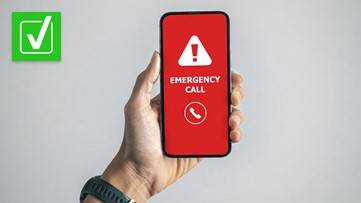Many modern ovens come with a self-cleaning function, which is intended to make the cleaning process simpler.
The self-cleaning feature works by generating high temperatures in order to burn any food, oils, or other residue inside the oven to ashes, making it easier to wipe off.
Viral posts and comments online claim the self-cleaning function on ovens can be dangerous, potentially leading to oven damage and fires.
VERIFY reader Ian reached out to ask if these claims are true.
THE QUESTION
Are there safety concerns with using the self-cleaning feature on an oven?
THE SOURCES
- James Copeland, director of technical services at Prism Specialties
- United States Consumer Product Safety Commission
- Whirlpool
- Samsung
- Maytag
- Penn Medicine
- GE Appliances
- P.C. Richard & Son
THE ANSWER
Yes, there are safety concerns with using the self-cleaning feature on an oven. The self-clean feature can be used, but specific instructions must be carefully followed to mitigate risks.
WHAT WE FOUND
Experts say people can use the self-cleaning oven feature, but there are potential risks if instructions are not properly followed or if the function is overused. The feature does create high temperatures and can emit fumes, and it shouldn’t be used on a regular basis.
Multiple sources, including popular oven manufacturers, provide safety instructions for users to follow.
It’s important to properly ventilate the kitchen when running the self-cleaning mode. When the oven heats up to high temperatures to burn residue, it can produce smoke and fumes.
“Dependent upon what’s been spilled in the oven cavity, it can even produce carbon monoxide,” James Copeland, director of technical services at Prism Specialties says.
Carbon monoxide is an odorless, colorless gas that can kill people and animals who breathe enough of it. It’s typically produced by “the incomplete burning of any material containing carbon,” which can include oils, according to Penn Medicine.
Copeland recommends opening up windows in the house to keep everything ventilated and making sure you have a working carbon monoxide detector.
Pets and children should not be in the area of an oven with the self-cleaning function in use. The smoke and fumes could irritate them, and the hot surface poses a burn risk.
There is also a fire risk if there is a large backup of oils and fats in the oven. To prevent fire or additional smoke, Copeland recommends wiping down the oven after each use.
The CSPC says that in addition to food residue backup, any pots, plasticware and paper towels should be removed from the area to avoid fire risk.
If your oven is on fire, do not try to open it. Exposure to oxygen will make things worse, Copeland says.
You should also never leave an oven unattended while using the self-cleaning function. It’s important to be able to monitor the oven and make sure everything is properly working, P.C. Richard & Son says. Once the self-cleaning cycle is finished, you should not try to handle the oven until it cools off completely, the company adds.
If you want to suspend the self-cleaning feature mid-cycle, the CSPC says that “you can always stop the self-cleaning feature mid-cycle if you need to, consult the manufacturer’s instructions.”
Both Samsung and Maytag say you should never leave the racks inside the oven while self-cleaning due to the heat of the oven. Self-cleaning ovens can reach temperatures of up to 800 degrees Fahrenheit, Whirlpool says.
“Leaving the racks in during this process can result in warping, discoloration, and even potential damage to the oven's internal components,” Samsung explains.
To clean oven racks separately, you should let them soak in a tub with warm water and dish soap for a few hours. Then, use a soft brush to get rid of any additional residue, Samsung says.
In general, no loose items should be left in the oven with self-cleaning mode running. You should “remove any loose items to prevent damage: oven racks, the broiler pan, all cookware, foil and any plastic on the range cooktop,” Maytag says.
The U.S. Consumer Product Safety Commission, which researches potential product hazards, told VERIFY that reports of damage from self-cleaning ovens are not common. “Generally, staff received relatively few reports involving self-cleaning oven complaints,” the representative said.
Whirlpool explains that the self-cleaning function is designed to be a heavier-duty clean. The best time to run the function is “before excessive soils accumulate to avoid excessive smoke and fumes during oven cleaning.”
P.C. Richard & Son recommends using the self-cleaning feature “once every six months,” but adds that “spacing them out further isn't a bad idea.”
Copeland recommends that you limit use of the self-cleaning mode to once a year. With the high heat, components could start to break down.
“Every electronic has tolerance ratings,” and the components “will start to get pushed to their tolerances, and it shortens the life of those components,” Copeland explains.
If you have a self-cleaning oven but want to clean it yourself instead, you can do so using soap and water, Whirlpool says.
You should not use commercial oven cleaners to clean a self-cleaning oven, both Maytag and GE say. Commercial oven cleaners can “cause etching and discoloration of the liner,” leading to the self-cleaning feature not working properly, GE explains.
These cleaners can also add to the chemical fumes exhausted by the self-cleaner, Copeland says.
This story is also available in Spanish / Lee este artículo también en español: Sí, existen preocupaciones de seguridad con el uso de la función de autolimpieza de un horno












